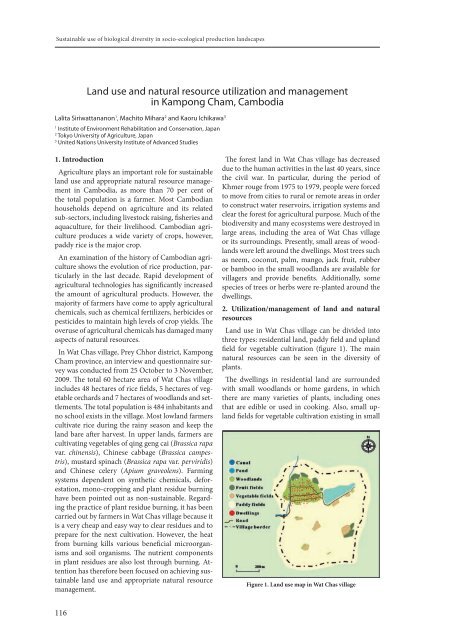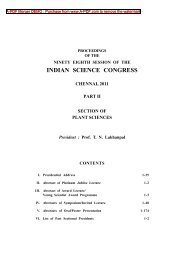sustainable use of biological diversity.pdf - India Environment Portal
sustainable use of biological diversity.pdf - India Environment Portal
sustainable use of biological diversity.pdf - India Environment Portal
You also want an ePaper? Increase the reach of your titles
YUMPU automatically turns print PDFs into web optimized ePapers that Google loves.
Sustainable <strong>use</strong> <strong>of</strong> <strong>biological</strong> <strong>diversity</strong> in socio-ecological production landscapes<br />
Land <strong>use</strong> and natural resource utilization and management<br />
in Kampong Cham, Cambodia<br />
Lalita Siriwattananon 1 , Machito Mihara 2 and Kaoru Ichikawa 3<br />
1<br />
Institute <strong>of</strong> <strong>Environment</strong> Rehabilitation and Conservation, Japan<br />
2<br />
Tokyo University <strong>of</strong> Agriculture, Japan<br />
3<br />
United Nations University Institute <strong>of</strong> Advanced Studies<br />
1. introduction<br />
Agriculture plays an important role for <strong>sustainable</strong><br />
land <strong>use</strong> and appropriate natural resource management<br />
in Cambodia, as more than 70 per cent <strong>of</strong><br />
the total population is a farmer. Most Cambodian<br />
ho<strong>use</strong>holds depend on agriculture and its related<br />
sub-sectors, including livestock raising, fisheries and<br />
aquaculture, for their livelihood. Cambodian agriculture<br />
produces a wide variety <strong>of</strong> crops, however,<br />
paddy rice is the major crop.<br />
An examination <strong>of</strong> the history <strong>of</strong> Cambodian agriculture<br />
shows the evolution <strong>of</strong> rice production, particularly<br />
in the last decade. Rapid development <strong>of</strong><br />
agricultural technologies has significantly increased<br />
the amount <strong>of</strong> agricultural products. However, the<br />
majority <strong>of</strong> farmers have come to apply agricultural<br />
chemicals, such as chemical fertilizers, herbicides or<br />
pesticides to maintain high levels <strong>of</strong> crop yields. The<br />
over<strong>use</strong> <strong>of</strong> agricultural chemicals has damaged many<br />
aspects <strong>of</strong> natural resources.<br />
In Wat Chas village, Prey Chhor district, Kampong<br />
Cham province, an interview and questionnaire survey<br />
was conducted from 25 October to 3 November,<br />
2009. The total 60 hectare area <strong>of</strong> Wat Chas village<br />
includes 48 hectares <strong>of</strong> rice fields, 5 hectares <strong>of</strong> vegetable<br />
orchards and 7 hectares <strong>of</strong> woodlands and settlements.<br />
The total population is 484 inhabitants and<br />
no school exists in the village. Most lowland farmers<br />
cultivate rice during the rainy season and keep the<br />
land bare after harvest. In upper lands, farmers are<br />
cultivating vegetables <strong>of</strong> qing geng cai (Brassica rapa<br />
var. chinensis), Chinese cabbage (Brassica campestris),<br />
mustard spinach (Brassica rapa var. perviridis)<br />
and Chinese celery (Apium graveolens). Farming<br />
systems dependent on synthetic chemicals, deforestation,<br />
mono-cropping and plant residue burning<br />
have been pointed out as non-<strong>sustainable</strong>. Regarding<br />
the practice <strong>of</strong> plant residue burning, it has been<br />
carried out by farmers in Wat Chas village beca<strong>use</strong> it<br />
is a very cheap and easy way to clear residues and to<br />
prepare for the next cultivation. However, the heat<br />
from burning kills various beneficial microorganisms<br />
and soil organisms. The nutrient components<br />
in plant residues are also lost through burning. Attention<br />
has therefore been foc<strong>use</strong>d on achieving <strong>sustainable</strong><br />
land <strong>use</strong> and appropriate natural resource<br />
management.<br />
The forest land in Wat Chas village has decreased<br />
due to the human activities in the last 40 years, since<br />
the civil war. In particular, during the period <strong>of</strong><br />
Khmer rouge from 1975 to 1979, people were forced<br />
to move from cities to rural or remote areas in order<br />
to construct water reservoirs, irrigation systems and<br />
clear the forest for agricultural purpose. Much <strong>of</strong> the<br />
bio<strong>diversity</strong> and many ecosystems were destroyed in<br />
large areas, including the area <strong>of</strong> Wat Chas village<br />
or its surroundings. Presently, small areas <strong>of</strong> woodlands<br />
were left around the dwellings. Most trees such<br />
as neem, coconut, palm, mango, jack fruit, rubber<br />
or bamboo in the small woodlands are available for<br />
villagers and provide benefits. Additionally, some<br />
species <strong>of</strong> trees or herbs were re-planted around the<br />
dwellings.<br />
2. utilization/management <strong>of</strong> land and natural<br />
resources<br />
Land <strong>use</strong> in Wat Chas village can be divided into<br />
three types: residential land, paddy field and upland<br />
field for vegetable cultivation (figure 1). The main<br />
natural resources can be seen in the <strong>diversity</strong> <strong>of</strong><br />
plants.<br />
The dwellings in residential land are surrounded<br />
with small woodlands or home gardens, in which<br />
there are many varieties <strong>of</strong> plants, including ones<br />
that are edible or <strong>use</strong>d in cooking. Also, small upland<br />
fields for vegetable cultivation existing in small<br />
figure 1. land <strong>use</strong> map in Wat chas village<br />
116
















